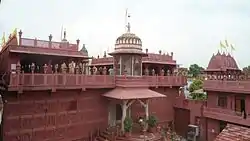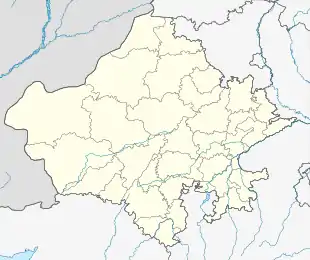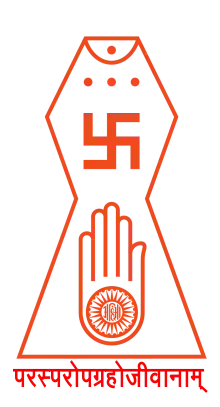Sanghiji
Shri Digamber Jain Atishya Kshetra Mandir, Sanghiji is an ancient Jain temple in Sanganer, Rajasthan made of red stone. The ancient Shri Digamber Jain temple of Sanganer is 16 km from Jaipur.
| Shri Digamber Jain Atishya Kshetra Mandir, Sanghiji | |
|---|---|
 Sanganer Temple | |
| Religion | |
| Affiliation | Jainism |
| Deity | Rishabhanatha |
| Governing body | Management committee Shri Digamber Jain Atishaya Kshetra Mandir |
| Location | |
| Location | Sanganer, Jaipur, Rajasthan |
 Sanghiji | |
| Geographic coordinates | 26°48′54″N 75°47′10″E |
| Temple(s) | 1 |
| Website | |
| sanghijimandir | |
| Part of a series on |
| Jainism |
|---|
 |
|
|
About Temple
The idol of principal deity of this temple, Lord Rishabhanatha (Adinatha), the first Tirthankara, is supposed to be 4000 years old.[1]
In the midst of underground portion, there is located an ancient small temple guarded by the Yaksha. The sacred temple has seven underground floors which are kept closed due to old religious beliefs and visitors are not allowed to see them. It is said that only a Balyati ascetic Digambara saint can enter in it and is able to bring out the idols of this underground temple for a limited period, which is declared and decided previously.
Temple also has a dharamshala equipped with all modern facilities including Bhojanalaya.
Architecture
The last phase of this temple was completed in the 10th century A.D., according to the inscription of V.S. 1011 in one of the Toranas. It has sky-high shikharas and the inner sanctum is a stone shrine with sky-high eight shikharas (pinnacles). Sanghiji temple considered a great speciman for Hindu and Jain architecture. The larger shrine is built using marble and sandstone in the 10th century and the smaller shrine is rich with ornate carvings of the temple using the white marble is comparable to that of Dilwara Temples in Mount Abu.[2][3][4]
Precious Idols
Inner temple has three pinnacles in the centre is an idol of Parshwanath with 7 serpent hoods. All around it, are carvings of lotuses, creepers and elephants pouring water from pitchers held in their trunks. But the main idol is that of Adinath, installed in the shrine behind this.
In 1999, Muni Sudhasagar visited the temple and brought thirty-nine valuable Jain idols. He claimed that he brought the idols from the forth underground floor and encountered many Yaksha (in the form of snakes) protecting the treasure.[4]
Gallery
 Front Vedi
Front Vedi Shikhar
Shikhar Rishabhanatha Idol
Rishabhanatha Idol.jpg.webp) Murals on wall
Murals on wall
Notes
- Shri Digamber Jain Atishaya Kshetra Mandir, Sanghiji, Sanganer, Jain Teerth
- Coolidge 1879, pp. 161-162.
- Titze 1998, p. 142.
- Parihar 2000.
References
- Coolidge, Archibald Cary (1879), The Rajputana Gazetteer, Gazetteer of India, 2, Rajasthan: Office of the Superintendent of Government Print
- Titze, Kurt (1998), Jainism: A Pictorial Guide to the Religion of Non-Violence (2 ed.), Motilal Banarsidass, ISBN 978-81-208-1534-6
- Ashish, Jain temple in Sanganer, famousitems.in
- Parihar, Rohit (11 December 2000), Digambar monk's rebuilding mission divides Jains, India Today
- Sanganer, Rajasthan tourism